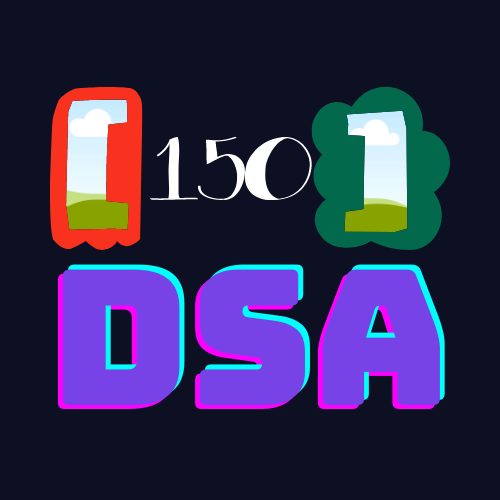
150 DSA
Basic of Programming
Learn fundamental concepts and principles to build a strong foundation in programming and problem-solving.
Explore NowPatterns
Discover the power of patterns in programming and unlock efficient solutions for common coding challenges.
Explore NowFunctions Problem
A reusable block of code that performs a specific task, enhancing code organization and reusability in programming.
Explore NowArrays and Strings
Learn the fundamentals of working with arrays and strings, including indexing, searching, sorting, and basic string operations.
Explore NowRecursion and Backtracking
Learn the power of recursion and backtracking techniques to solve complex problems by breaking them down into smaller, manageable steps.
Explore NowBig O Notation
Understand the efficiency and scalability of algorithms with Big O notation, a measure of algorithm performance in terms of input size.
Explore NowStacks and Queues
Learn about stack and queue data structures used for organizing and managing data. Stacks follow a last-in, first-out (LIFO) approach, while queues follow a first-in, first-out (FIFO) approach.
Explore NowLinked List
A linked list is a linear data structure consisting of nodes that store data and references to the next node, enabling dynamic memory allocation and efficient insertion, deletion, and traversal operations.
Explore NowTrees And Graphs
Trees and graphs are essential data structures used to represent hierarchical relationships and complex networks, enabling efficient manipulation and traversal in various algorithms and applications.
Explore NowHashmap and Heap
Hashmap is a key-value data structure that provides fast access to values, while Heap is a binary tree-based structure used for efficient element insertion, deletion, and finding the minimum or maximum value.
Explore NowDynamic Programming
Dynamic programming is an algorithmic technique used to solve complex problems by breaking them down into smaller overlapping subproblems and storing their solutions for efficient computation.
Explore NowSorting and Searching
Sorting and searching algorithms are essential tools in computer science, enabling the organization of data in a specific order and efficient retrieval of desired elements from large collections.
Explore NowObject-oriented Design
Object-oriented design in C++ focuses on designing and implementing modular and reusable code using classes, objects, inheritance, and polymorphism to achieve code organization and maintainability.
Explore NowSTL in cpp
Standard Template Library (STL) is a powerful library that provides reusable data structures, algorithms, and containers, enhancing the efficiency and productivity of C++ programming.
Explore NowBit Manipulation
Bit Manipulation involves performing logical and arithmetic operations on individual bits, providing efficient solutions for problems in cryptography, compression, and low-level programming.
Explore NowMath and Logic puzzles
Math and logic puzzles are engaging brain teasers that require critical thinking and problem-solving skills to solve mathematical and logical challenges in a fun and interactive way.
Explore NowBinary Search
Binary Search is a fast search algorithm that finds the position of a target value within a sorted array.
Explore NowTwo Pointers
Two Pointers is a technique that uses two pointers to traverse or manipulate elements in an array or linked list efficiently.
Explore NowSliding Window
Sliding Window is a technique that maintains a dynamic window to efficiently process subarrays or subsequences in an array or string.
Explore NowGreedy Algorithm
Greedy is an algorithmic paradigm that makes locally optimal choices at each stage.
Explore NowTries
Tries, or prefix trees, are data structures used for efficient string searching and retrieval.
Explore NowProject
Explore a collection of hands-on projects that apply various concepts and technologies, providing practical experience and enhancing your problem-solving skills in real-world scenarios.
Explore NowResume Building Tools
Discover helpful tools and resources to create professional resumes that highlight your skills, experience, and qualifications effectively.
Explore Now